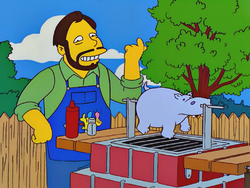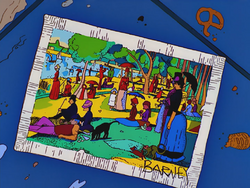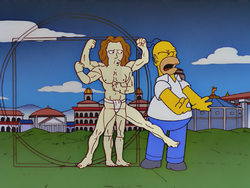
Difference between revisions of "Mom and Pop Art/References"
Wikisimpsons - The Simpsons Wiki
Simpsons88 (talk | contribs) m (→Cultural references) |
Simpsons88 (talk | contribs) m (→Cultural references) |
||
| Line 3: | Line 3: | ||
== Cultural references == | == Cultural references == | ||
| − | *The | + | *The title of the episode is a reference to {{w|Pop art}}. |
*In the episode's [[Mom and Pop Art/Gags#Couch gag|couch gag]], the Simpsons ride the couch just like {{w|Slim Pickens}}' rides the bomb in ''{{w|Dr. Strangelove}}''. | *In the episode's [[Mom and Pop Art/Gags#Couch gag|couch gag]], the Simpsons ride the couch just like {{w|Slim Pickens}}' rides the bomb in ''{{w|Dr. Strangelove}}''. | ||
[[File:Doug Vaccaro BBQ.png|250px|thumb|[[Doug Vaccaro]] resembles {{w|Richard Karn}}'s character, {{w|Al Borland}}, from ''{{w2|Home Improvement|TV series}}''. Similar music from the series is heard as well]] | [[File:Doug Vaccaro BBQ.png|250px|thumb|[[Doug Vaccaro]] resembles {{w|Richard Karn}}'s character, {{w|Al Borland}}, from ''{{w2|Home Improvement|TV series}}''. Similar music from the series is heard as well]] | ||
Revision as of 17:10, July 1, 2021
|
|||||||||
|
|
|
Cultural references
- The title of the episode is a reference to Pop art.
- In the episode's couch gag, the Simpsons ride the couch just like Slim Pickens' rides the bomb in Dr. Strangelove.

Doug Vaccaro resembles Richard Karn's character, Al Borland, from Home Improvement. Similar music from the series is heard as well
- Doug Vaccaro resembles Richard Karn's character, Al Borland, from the TV series Home Improvement. Similar music is also heard playing when Homer starts building the BBQ pit.
- Doug Vaccaro says he participated in the sitcom Toolin' Around, a play-on-words of the film Foolin' Around.
- Chief Wiggum treats Homer as "Santa Claus", and also calls him Saint Nick, Kris Kringle and Père Noël.
- When Wiggum asks the mafia what were they throwing to the trash, Louie answers "a Beanie Baby", a reference to the American line of stuffed toys Beanie Babies.
- The art gallery Louvre: American Style is a reference to the TV show Love, American Style and the Louvre, Paris.
- A sculpture of David by Michelangelo made with ordinary home things is seen in the gallery.
- The fact of artist Jasper Johns being portrayed as a kleptomaniac is a reference to his art style, as he usually uses objects from everyday life for his artwork.
- Mr. Burns once missed the opportunity to buy Picasso's Guernica because he bought the rights for the song "White Christmas". The song was written by Irving Berlin for the musical film Holiday Inn and one of its versions was the world's best-selling single.
- Homer owned some Disney memorabilia.
- Homer remembers his "schoolgirl days" when he painted Ringo Starr, whom Marge was fond of.
- The scene of Homer at the garage yelling at his art is a reference to the 1959 comedy horror film A Bucket of Blood. In the film, Walter Paisley (portrayed by Dick Miller) talks to a piece of clay demanding it to take the shape of a nose.
- Barney tries to pay Moe with his version of A Sunday Afternoon on the Island of La Grande Jatte by Georges Seurat.
- Homer reads Art in America, an illustrated monthly, international magazine concentrating on the contemporary art world in the US.
- Homer says he visited Machu Picchu with Barney once.
- At Homer's gallery, The Rich Texan says he has bought a painting by Rembrandt.
- Homer mentions American comedian Ray J. Johnson. He also sings "You can call him Ray, or you can call him Jay...", a reference to a Natural Light lager commercial from 1978.
- Marge mentions Michelangelo and former basketball player Shaquille O'Neal.
- The Springsonian Museum takes its name from the Smithsonian Institution, composed by a group of museums and research centers. Inside the museum:
- The Greek sculpture Discobolus is seen.
- There is a painting with Akbar and Jeff from Matt Groening's Life in Hell.
- The standing pencil is by Claes Oldenburg, a Swedish-born American sculptor.
- The Dogano, San Giorgio, Citella, from the Steps of the Europa by Joseph Turner is analysed by Marge.
- Harlequin (1901) and The Old Guitarist from Picasso's Blue Period are seen.
- Les Demoiselles d'Avignon, a famous proto-cubist work also by Picasso, is seen.
- Homer drools when he sees a parody of Campbell's Soup Cans by Andy Warhol.
- In Homer's dream:
- Homer is lying in a similar way to the woman in The Sleeping Gypsy by Henri Rousseau.
- The Vitruvian Man, by Leonardo da Vinci, attacks Homer.
- The Three Musicians by Picasso transform their instruments into guns and start shooting at Homer. One of the musicians says "Hasta la vista, baby", the famous catchphrase from Terminator 2: Judgment Day.
- Homer is in The Persistence of Memory world, a painting by Salvador Dalí.
- Lisa mentions Christo, the conceptual artist that worked on huge outdoor projects. Lisa mentions some of Christo and Jeanne-Claude's works, including the Wrapped Reichstag and The Umbrellas.
- Homer converts Springfield into "Venice without the black plague".
- "Arrivederci Roma" by Renato Rascel is heard at the end of the episode and during the credits.
Trivia
- The writer of this episode, Al Jean, partially wrote this episode whilst waiting in line for an amusement attraction. This was heard in the audio commentary from Season 4's episode Selma's Choice.
- For a time, the scene where Marge asks Homer to take down the hostage ribbons from the old oak tree was censored after 1999 Kosovo War. However, the scene is still censored in some countries and on Disney+.
Goofs
- When Jasper Johns is seen stealing a light bulb in the art museum, the light continues to shine even when he takes the bulb out and runs off.
- When Homer has finished his 'BBQ pit', it has one of his shoes in it, the next shot shows a shoe shaped brick.
Continuity
- One of the fishermen from "Das Bus" appears at the art show.
International versions
- In the French dub of the show, the roles are reversed so Homer has to read the English instructions instead of the French instructions.
- In Latin America, the scene where Marge asks Homer to take down the hostage ribbons from the old oak tree was cut.


